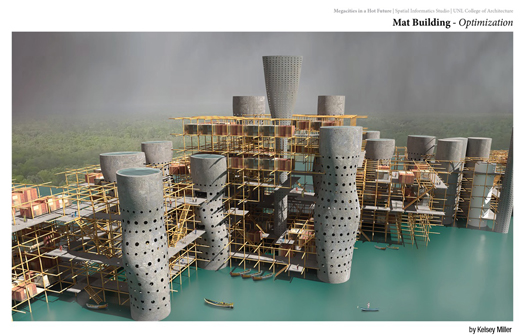Architecture Studio Explores Solutions for Environmental Sustainability Using AI Technology
Technology and artificial intelligence (AI) are increasingly touching every aspect of our lives and in many ways we wouldn’t expect. AI has the ability to assist cybersecurity in preventing future attacks, analyzing wildlife habitat, predicting future pricing patterns and even shedding light on global environmental remediations. Fostering the next generation of design innovators, this semester Assistant Professor David Newton’s master level, Spatial Informatics Studio, a collaboration with Omaha-based HDR, Inc., is using AI technologies to explore solutions for sustainable hyper-dense architecture in mega cities around the world. With two thirds of the world’s population predicted to live in larger cities by 2050, according to the United Nations, more sustainable solutions are in demand.
Newton explains, by using the AI generative processes, architects can explore design variations more efficiently than the traditional design methods. AI technologies can also help architects consider the environmental impacts of potential designs at the early stages of the development process and change course if need be.
“How will AI impact architectural practice in the next 10-20 years? How will it transform the design process? How can AI be used creatively by the allied design fields to raise human imagination to new heights instead of replacing it?” said Newton. “This studio explores these questions through the topic of generative design which creates designs through the use of algorithms, or rule systems.”
Partnering with HDR, students were given an intimate view of how generative designs are being applied to real-world projects and inspiration for integrating these methods into their studio work.
“The practical implementations of the generative processes by HDR have added to the theoretical work in the studio by shedding light on the current problems that practice is currently facing and providing insight on how new generative processes might be developed to help address these issues,” said Newton.
Plus, industry partnerships like this are essential inroads for student engagement with the profession.
“Our HDR collaboration with David Newton’s Spatial Informatics Studio has been a wonderful opportunity to create a two-way street for students to connect and learn from professionals while simultaneously allowing us as professionals to learn and reflect on the questions, thoughts and proactive studio work done by the students,” said Daniel Williamson, HDR Computational Design Lead. “This relationship better prepares students for their professional careers as they can see the work being done across the industry, and ask questions directly to professionals in a more informal format.”
With trend projections predicting a hotter, denser and more resource-depleted planet in the coming decades, Newton challenged his students to create solutions for the impacts of climate change. They started their project by developing a body of research on high-density buildings and how climate change may affect select megacities by 2070. The students then created methods for using multi-objective optimization and generative algorithms.
Utilizing the generative process, students used the remainder of the semester to explore the myriad of possibilities for megacity, high-density buildings capable of efficiently integrating mixed programs with high population densities into small, energetic and healthy configurations.
“It is my hope that students will leave the course with valuable knowledge and skill sets related to cutting-edge applications of computation in the design process and be prepared with the necessary foundation to become leaders in the use of generative processes in the profession,” said Newton.
Students in Newton’s studio are excited about the prospects afforded by AI technology and how it could transform the profession and the way people live.
“We hope it changes the future by providing better options for more efficient dwellings and dealing with the problems of global warming,” said Ian Murphree, M.Arch student.

 Study Architecture
Study Architecture  ProPEL
ProPEL 
